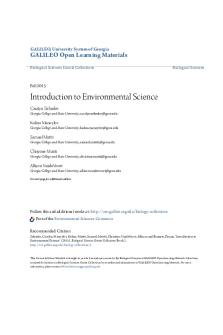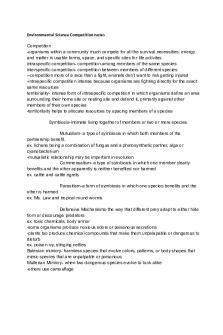Environmental Science - Lecture notes - Chapter 4 PDF

| Title | Environmental Science - Lecture notes - Chapter 4 |
|---|---|
| Author | Melissa Yang |
| Course | Environmental Science |
| Institution | The Pennsylvania State University |
| Pages | 11 |
| File Size | 855.9 KB |
| File Type | |
| Total Downloads | 82 |
| Total Views | 140 |
Summary
Download Environmental Science - Lecture notes - Chapter 4 PDF
Description
Chapter 4 – Species Interactions and Community Ecology Community: - Set of populations of different species living together in a particular area - Community ecology studies 1. Species interactions 2. Good webs 3. Response to disturbance 4. Invasive species 5. Biomes Species Interactions
Competition: multiple organisms seeking same limited resource 1. Competitive exclusion (one takes over resources) 2. Resource partitioning( use slightly different resources or in different ways )
Resource Partitioning
Predation: one species hunts, tracks, kills, prey species - Can lead to cycles in numbers of predators and prey - Adaptations to avoid predators
Avoiding Predation
Parasitism: one species depends on, but also harms, host species - Does not usually kill host Ex: Lamprey, tapeworms, cowbirds, insects
Herbivory: animals consuming plants - Usually does not kill plant, but affects its growth and reproduction - Plant defenses Ex: Thorns, spines, hairs, toxic chemicals
Mutualism: both species benefit from interaction Ex: pollination, plant roots and fungi, intestines Ant- Acacia Mutualism
Feeding Hierarchy - Trophic level: rank in feeding hierarchy - Producers - Consumers - Decomposers and Detritivores: - Organisms that break down leaf litter, waste, dead bodies, and other non-living matter - Bacteria, fungi, millipedes, soil insects
Food Chain
Food Chain
Energy Loss at Trophic Levels - Most energy is lost as heat - Only about 10% of energy passes from one trophic level to next - Makes “ Energy Pyramid”
- Pyramid also applies to numbers and biomass - Key implication: eating at lower trophic levels
Food Webs - Visual map of feeding relationships and energy flow among trophic levels - More realistic than food chain (though still not ALL interactions)
Species Impacts - Some species have a stronger impact on communications than others - Beavers and prairie dogs physically modify - Decomposers recycle matter - Keystone species: have wide impact even though not abundant
Community Disturbance - Flood, landslide, climate change, human impact - Communities respond in different ways - Succession: 1. Predictable series of changes following disturbance 2. Primary succession- no life (volcano, glacier) 3. Secondary- some life remains (fire, hurricane, logging, farming)
Primary Succession
Secondary Succession Invasive Species: spreads widely and rapidly becomes dominant - Interferes with community’s normal functioning - Usually non-native (alien, exotic ) Ex: Zebra mussels from ship ballast water - Native to southern Russia
Zebra Mussel Impacts
Effect of 1991 Zebra Mussel Invasion on Fish Populations
Futher Zebra Mussel Effects on Fish
Solutions to Invasive - Sometimes they are beneficial Ex: European honeybee, ornamental plants, pest control - National Invasive Species Act 1996: 1. Regulate ballast water release 2. Funding for control and eradication Preventing Invasive - environmental model can help predict where a species might spread - This area could then be closely monitored - Increase ground surveys and satellite observations Restoration Ecology - Study of historical conditions of communities before human alteration - Devise ways to return to earlier condition - Goal can be functionality - Or “pre- settlement” Ex: Tall-grass prairie
Florida Everglades
Biomes: major regional complex of similar communities - Recognized by characteristic plants - Determined by temperature and rain
Temperate Deciduous Forest...
Similar Free PDFs

Environmental Science Lecture notes
- 25 Pages

Environmental Science
- 16 Pages

Environmental Science Module 1
- 4 Pages

Chapter-4 - Lecture notes
- 67 Pages

Environmental Science and Engineering
- 109 Pages

Chapter 4 lecture notes
- 6 Pages

Chapter 4 - Lecture notes 4
- 1 Pages

Chapter 4 Lecture Notes
- 5 Pages
Popular Institutions
- Tinajero National High School - Annex
- Politeknik Caltex Riau
- Yokohama City University
- SGT University
- University of Al-Qadisiyah
- Divine Word College of Vigan
- Techniek College Rotterdam
- Universidade de Santiago
- Universiti Teknologi MARA Cawangan Johor Kampus Pasir Gudang
- Poltekkes Kemenkes Yogyakarta
- Baguio City National High School
- Colegio san marcos
- preparatoria uno
- Centro de Bachillerato Tecnológico Industrial y de Servicios No. 107
- Dalian Maritime University
- Quang Trung Secondary School
- Colegio Tecnológico en Informática
- Corporación Regional de Educación Superior
- Grupo CEDVA
- Dar Al Uloom University
- Centro de Estudios Preuniversitarios de la Universidad Nacional de Ingeniería
- 上智大学
- Aakash International School, Nuna Majara
- San Felipe Neri Catholic School
- Kang Chiao International School - New Taipei City
- Misamis Occidental National High School
- Institución Educativa Escuela Normal Juan Ladrilleros
- Kolehiyo ng Pantukan
- Batanes State College
- Instituto Continental
- Sekolah Menengah Kejuruan Kesehatan Kaltara (Tarakan)
- Colegio de La Inmaculada Concepcion - Cebu







